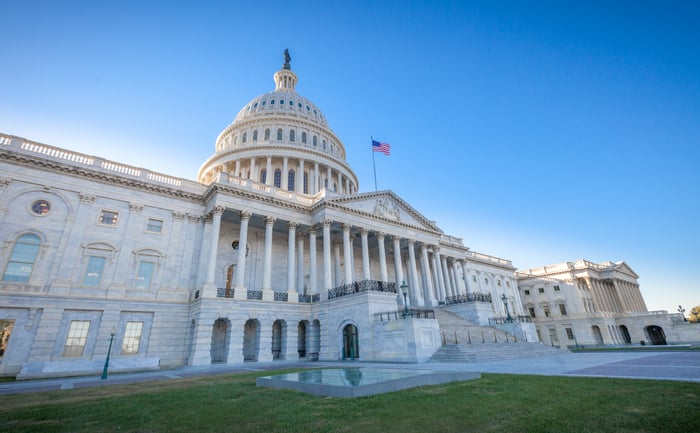Over the past eight-plus decades, we've watched Social Security grow into the most important social program in this country. Today, close to 65 million people receive a monthly payout from the program, with over 22 million of these folks pulled out of poverty thanks to their benefit.
But the program is in big trouble.

Image source: Getty Images.
Every year since Social Security first began paying benefits (1940), the Social Security Board of Trustees has released a report that examines the short-term (10-year) and long-term (75-year) outlook for the program. Since 1985, the OASDI Trustees' report has cautioned that program outlays would exceed collected revenue over the long term. Put another way, Social Security has unfunded obligations over the next 75 years. To be a bit more specific, the latest Trustees report estimates that Social Security's $2.9 trillion in asset reserves (i.e., its net cash surpluses built up since inception) would run out by 2035.
To be clear: Social Security isn't going bankrupt just yet. It has two recurring sources of revenue -- but if and when these asset reserves are depleted, an across-the-board benefit cut of up to 24% may await retired workers and survivor beneficiaries.
In total, the 2020 Trustees report estimates that Social Security is facing $16.8 trillion in unfunded obligations between 2035 and 2094, which is $2.9 trillion higher than in the previous year.
How exactly does the nation's top social program suddenly find itself on such poor financial footing? The answer lies with the following seven factors.

Image source: Getty Images.
1. Baby boomers are retiring
I'm not a fan of blaming baby boomers simply for being born, but their exodus from the labor force is weighing down the worker-to-beneficiary ratio. According to intermediate-cost model estimates from the Trustees report -- which represent what's most likely to happen -- the number of retired workers receiving benefits should surge from 45.1 million in 2019 to 64.6 million by 2035. Over that time, the worker-to-beneficiary ratio is expected to decline from 2.8-to-1 to 2.2-to-1.
As a reminder, the payroll tax revenue collected from workers was responsible for $945 billion of the $1.06 trillion in revenue collected for Social Security in 2019. So, yes, the retirement of boomers is a big deal.

Image source: Getty Images.
2. We're living longer than ever before
Another bittersweet concern is that we're living longer. Between 1940 and 2020, the average life expectancy at birth for Americans jumped from north of 64 years to almost 79 years.
On the one hand, living longer is fantastic. We get to spend more time with our friends and family, and do what we love. But it's not necessarily a great thing for the Social Security program.
According to data from the Social Security Administration, the average 65-year-old will live about 20 more years. Social Security was never designed to pay benefits for multiple decades. Further, the full retirement age -- i.e., the age at which retired workers can collect 100% of their monthly benefit, as determined by their birth year -- will have only risen by two years through 2022. Meanwhile, life expectancies are up by more than 15 years since 1940.
Put simply, longer average life spans are straining the Social Security program.

Image source: Getty Images.
3. Income inequality is on the rise
Social Security's woes can also be partly blamed on rising levels of income inequality.
The aforementioned 12.4% payroll tax, which does the heavy lifting for Social Security, is applied to earned income (wages and salary, but not investment income) ranging between $0.01 and $137,700, as of 2020. Approximately 94% of working Americans will earn less than $137,700 this year, meaning they'll be paying into Social Security on every dollar they earn. Earned income above $137,700 is exempt. Between 1983 and 2016, the amount of earned income escaping Social Security's payroll tax roughly quadrupled from north of $300 billion to $1.2 trillion.
Additionally, the well-to-do have little or no financial constraints when it comes to paying for preventative medical care or prescription medicines. The same can't be said for everyone else. As a result, the rich are living notably longer than everyone else and collecting bigger monthly benefits in the process -- further weighing down Social Security.

Image source: Getty Images.
4. Net legal immigration levels have been halved
Immigration is also a serious problem, albeit not for the reasons you might have read about.
As a whole, immigration is a net positive for the Social Security program. Most legal migrants into the U.S. tend to be young, and are therefore going to spend decades in the labor force contributing via the payroll tax. The Trustees' intermediate-cost model assumes a net average of 1,261,000 legal migrants entering the U.S. every year over the long-term.
However, net immigration rates into the U.S. have been sinking for the past two decades. In the most recent rolling five-year measurement from the World Bank, a net average of 954,806 legal migrants entered the U.S. annually between the second half of 2012 and the second half of 2017. Less legal (and undocumented) immigration will almost certainly weigh on the worker-to-beneficiary ratio.

Image source: Getty Images.
5. Birth rates are at all-time lows
Couples also bear part of the blame for Social Security's woes.
The program counts on a steady or rising level of births each year to offset the number of older workers leaving the labor force. The intermediate-cost model had been running with an assumption of 2 births per woman for years, but lowered this figure to 1.95 births per woman in 2020. This is a big reason we saw unfunded obligations jump by $2.9 trillion from the previous year.
In 2019, the U.S. birth rate hit an all-time low of 1.68 births per woman, which is actually below even the high-cost model estimate of 1.75 births per woman provided by the Trustees. Couples are waiting longer to get married and have children. They're having fewer unplanned pregnancies, and have been discouraged from having children by the poor state of the U.S. economy. Without a quick turnaround in birth rates, the worker-to-beneficiary ratio will be negatively impacted.

Image source: Getty Images.
6. The Fed has crippled Social Security's interest-earning capacity
Even the nation's central bank gets a wag of the finger.
The Federal Reserve is tasked with controlling and influencing monetary policy. It primarily does this by increasing or decreasing the federal funds rate, which is the overnight lending rate that banks charge one another. Moving this rate higher or lower causes ripples that influence interest rates.
With the U.S. economy currently in recession, and the Fed maintaining a predominantly dovish stance for much of the past decade, the federal funds rate is currently at a record-tying low range of 0% to 0.25%. This is great news for companies and individuals looking to borrow, but awful for anyone looking to generate interest income.
Social Security's $2.9 trillion in asset reserves are required by law to be invested in special-issue bonds and, to a lesser extent, certificates of indebtedness. The yields on newly issued bonds have been plummeting, with some yielding a meager 0.75%. In other words, the Fed's dovish monetary policy means less in the way of interest-earning capacity for Social Security.

Image source: Getty Images.
7. A Capitol Hill deadlock
Finally, point your finger at lawmakers on Capitol Hill.
Though lawmakers may be somewhat responsible for some of the issues described here, it's really their inability to find common ground to fix Social Security that's worthy of blame. For every year that Congress doesn't resolve Social Security's cash shortfall, it usually widens. The longer lawmakers wait to act, the costlier the fix will be on working Americans who form the backbone of the Social Security program.
Democrats and Republicans have each offered plenty of solutions on how best to resolve Social Security's shortcomings. But since both parties have solutions that work to strengthen the program, neither side feels compelled to find common ground with their opposition.
We can only hope that Congress finds a way to work together on a bipartisan solution sooner rather than.




